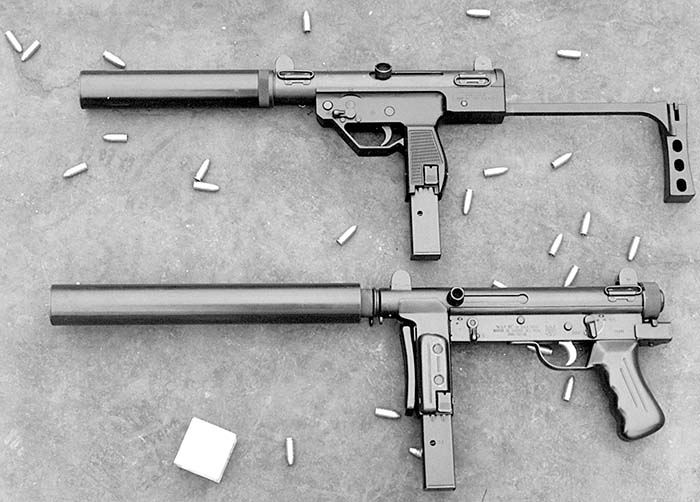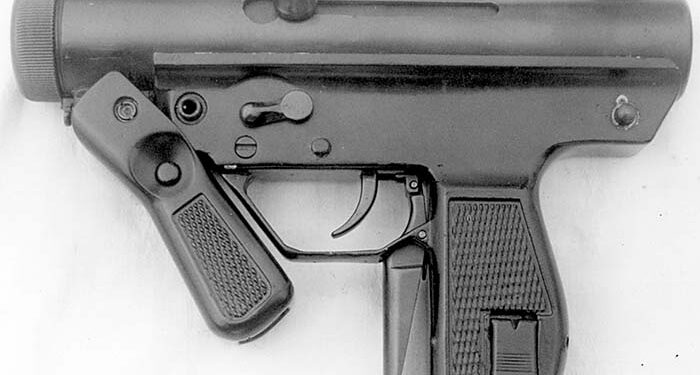By Ronaldo Olive
Having designed, series produced, and deployed its MGP-79/MGP-79A/MGP-87 series of 9 x 19 mm caliber submachine guns, Peruvian Navy’s SIMA-CEFAR organization had by the mid-1980s accumulated considerable experience and was ready to launch a more ambitious program. Those weapons, although possessing the due credit of having launched the country’s first-ever indigenous small arms manufacturing program, generally represented what is commonly termed as “second-generation” SMGS. Weapons like the WWII-vintage German MP38, British STEN, the American M3 Grease Gun, and many others that appeared worldwide after the War. Except for one or another refinement, Peru’s MGPs basically incorporated the same characteristics. Size and weight were two of them.
Even with the stock folded, the MGP-87, for example, was 500 mm long, and, minus magazine, its weight just about touched the 3-kg mark. When one opts or a submachine gun, he or she is clearly trading cartridge power and range for lightness and compactness. The search for “firepower in a compact package” has for long existed. In the 193os, the Royal, Astra, and Mauser “Schnellfeuer” machine pistols were unsuccessful attempts to achieve this goal. The American Ingram M10/M11 series was somewhat more (although not entirely) successful, and some other subguns (Israel’s Mini and Micro Uzis, and Germany’s H&K MP5K, for instance) later appeared to fill this highly specialized niche. Not to mention more recent, radical designs such as Britain’s Bushman IDW (Individual Defence Weapon) and Austria’s Steyr TMP (Tactical machine Pistol).
Local operational requirements and potential export market possibilities formed the basis for the development of the MGP-84 (at one time designated MGP-15), which has been in production at the Callao naval Base, near the capital city of Lima, for several years. Besides adoption by Peruvian forces, it has reportedly been exported to such countries as Argentina, Honduras, and Mexico.
Compactness was, obviously, a primary design objective. This has been remarkably well achieved in the MGP-84, whose telescopic (or wrap-around) bolt entirely surrounds the 166 mm-long barrel, pretty much in the same fashion of a Colt Government Model pistol, for example. The return spring is positioned in a similar way, too, encircling the barrel. Many people don’t favor placing any spring too close to a heat source (a hot barrel, in this case), as this may lead to losing its temper, and it still remains to be seen whether, in the long run, this problem is going to manifest in the Peruvian gun.

Following a current trend in small arms manufacture, synthetic material is used in the construction of the main body (pistol grip/magazine housing, trigger guard, and firing mechanism housing), to which the steel tubular receiver is attached by two removable pins. The buttstock consists of a steel arm and a synthetic buttplate, and neatly folds to the right side of the gun, thus reducing overall length from 503 to only 284 mm, a mere 67 mm longer than a Beretta Model 92 semi-auto pistol, for example. This easily allows the Mini to be carried concealed under a coat or jacket (the manufacturer offers a dedicated shoulder holster for that) and quickly brought into action. This should prove most useful for bodyguard duties.
I have been invited by SIMA-CEFAR to test fire the MGP-84 at one of the Peruvian Navy ranges at Callao. Since that intense training activity by Navy (“Marina de Guerra”) and Marine (“Infanteria de Marina”) combat teams was taking place everywhere at the time of my somewhat unscheduled visit, I could not count on a formal shooting range (paper targets, etc) for my use. Instead, I had at my disposition a reasonable free area, surrounded by sand dunes, with a usable range of roughly 50 meters, which comes to be a realistic firing distance as far as small submachine guns are concerned. Informal (empty soda bottles and wooden crates) targets happened to be spread over the place at every imaginable distance. Ammunition supply was plenty, consisting of locally made FAME and Brazilian CBC/Magtech 9 x 19 FMJ rounds.
Like the previous MGP-79 and MGP-87, the “84” employs 20- and 32-round magazines similar to and interchangeable with those of the Uzi family, which, for the record, finds wide acceptance by Peruvian armed and police forces. This type of box magazine is of the staggered-row, two-position feed type, which is easier to load by hand and requires reduced bolt effort to strip rounds and feed them into the chamber. Not at all surprisingly, the magazine catch button occupies the same (low, left side) position in the pistol grip and is a carbon copy of the Israeli guns, but nothing else relates the two designs.
Controls are adequately sized and located. The fire selector, situated just above the forward end of the unusually wide, very sturdy trigger guard, has the settings “S” (safety), forward; “1×1” (semi-auto), top; and “A” (automatic), to the rear. Its manipulation is done with the thumb of the left (supporting) hand, easily, quickly, and effortlessly. It has been a frequent practice in many guns to place the selector switch closer to the main grip so that it can be, tentative and optimistically, actuated with the thumb of the right (firing) hand, but in quite a few instances its shape and/or actual positioning prevents this from happening. So, the MGP-84 Mini solution is straightforward.
The cocking knob, at about 45 degrees to the left, is attached directly to, and reciprocates with the bolt. Its size is large enough to allow positive manipulation, and small enough to avoid snagging in clothes, pieces of individual gear, bushes, etc.
With the stock extended, the gun provides adequate comfort for accurate, aimed fire, mainly when one chooses the semi-automatic mode. The protected sights (U-notch, flip-type rear sight, and post front sight) are easy to acquire and adjustable for 100 meters (in my view, the maximum realistic engagement distance for such a short barrel)) and 200 meters (a most optimistic proposition). Anyway, my available range did not go past the 50-or-so-meter mark and the weapon proved entirely capable of consistently hitting man-sized targets. At shorter distances (say 10 to 15 meters), head shots may be a viable choice to deal with emergency tactical situations, such as in a hostage rescue mission.
Since the beginning, I was particularly anxious to try the Mini in the automatic mode, and I’ll tell you why. Similarly-sized SMGs (Ingrams, Mini and Micro Uzis, MP5Ks, etc.) have inherently a high cyclic rate of fire, usually in the region of 1000 to 1200 rounds per minute, which does nothing to help in controllability and, consequently, in practical accuracy … past arm’s length. Since SIMA-CEFAR literature mentioned 650-700 rounds per minute for the MGP-84, I was more than eager to try it.
Although the shooting was not instrument-monitored, my accumulated experience with buzzguns made me believe that the quoted figures are pretty real. Even during normally useless very long bursts, controllability remained excellent, both firing from the shoulder and from the waist level. Using trigger control alone, short, two-round bursts and single shots are simple to master after some familiarization.
If required, the Mini can be fired with the buttstock folded. You can do it single-handed, like a pistol, or even using the folded buttplate as a forward vertical grip. Be aware, however, that no matter what Hollywood suggests, this is a sure way to lose a lot in terms of accuracy: just do it in case of a real emergency … and at very close ranges!
The Peruvian submachine gun’s compact size makes it an ideal weapon for covert, low profile missions. Much more so if you fit it with a sound suppressor. In just a few seconds, unscrew the forward receiver cap and substitute it for the locally designed silencer unit, which, thus, attaches to the original barrel. It is relatively light, not too bulky, and, boy, does it work! Without requiring the use of subsonic ammunition, it effectively cuts down the firing signature to slightly more than the metallic noise of the reciprocating bolt. The added weight, in fact, increases firing stability, and were the MGP-84 one of my tools-of-trade, I’d probably have it with the suppressor on most of the time for serious business.
SIMA-CEFAR (renamed SIMA Electronica in 1996) also offers a semi-auto-only version of the gun, a sort of ultra-compact carbine designated MGP-84C (at one time, MGP-14), for those not requiring – or not allowed to have – an automatic weapon. Those creative Peruvians built and tested a stockless, assault pistol variant, the MGP-14 Micro, in 1994, but the project did not go beyond the prototype stage.
TECHNICAL SPECIFICATIONS MGP-84 Mini
Cartridge: 9 x 19 mm
Operation: Blowback, selective fire
Feed: 20- or 32-rd detachable box mag.
Weight: no magazine: 2.3 kg, full 32-rd magazine: 2.9 kg
Length: stock extended: 284 mm, stock folded: 284 mm
Barrel length: 166 mm
Cyclic rate of fire: 650-700 rounds/min.
| This article first appeared in Small Arms Review V2N5 (February 1999) |












